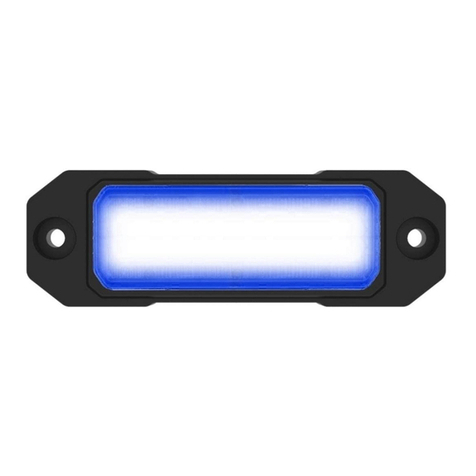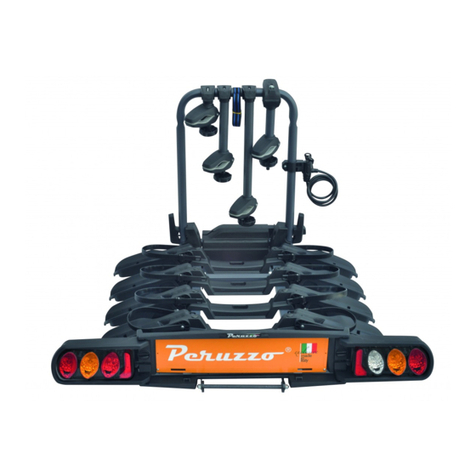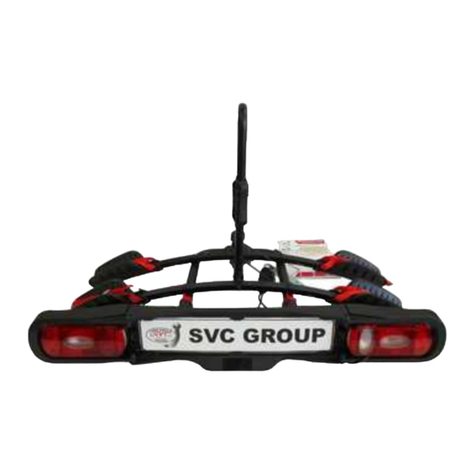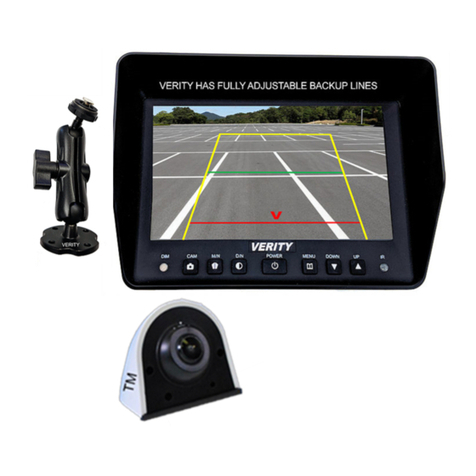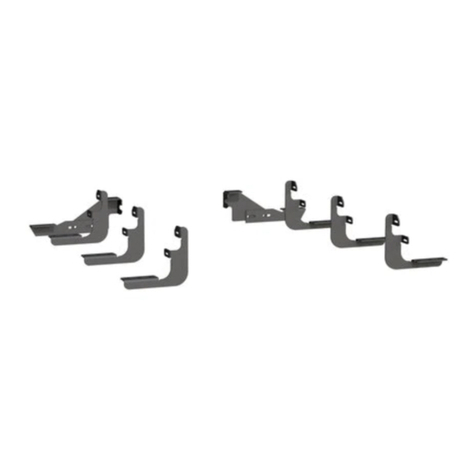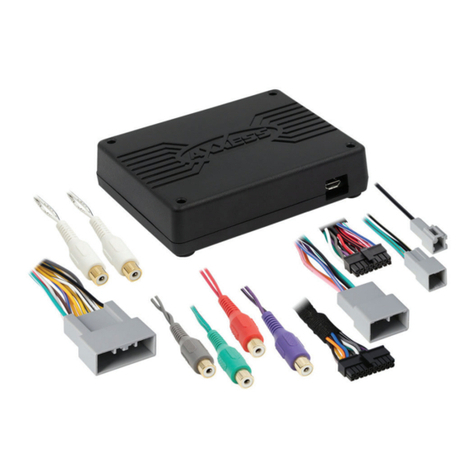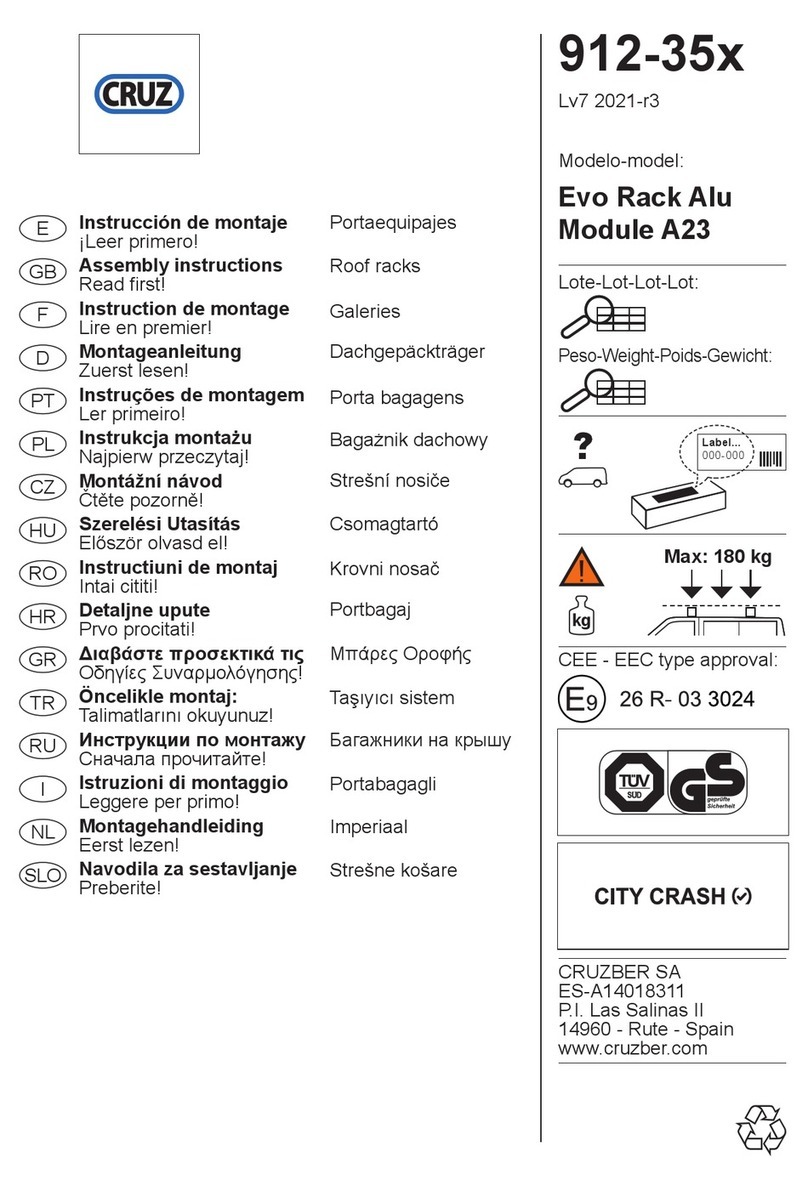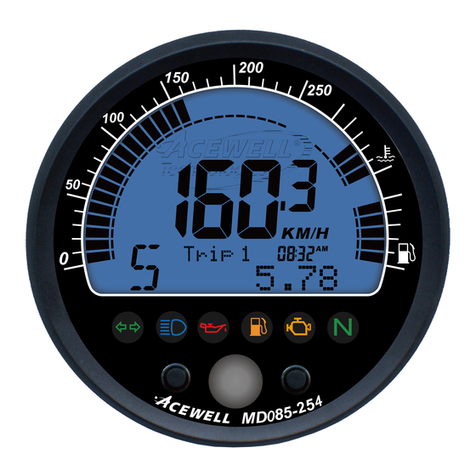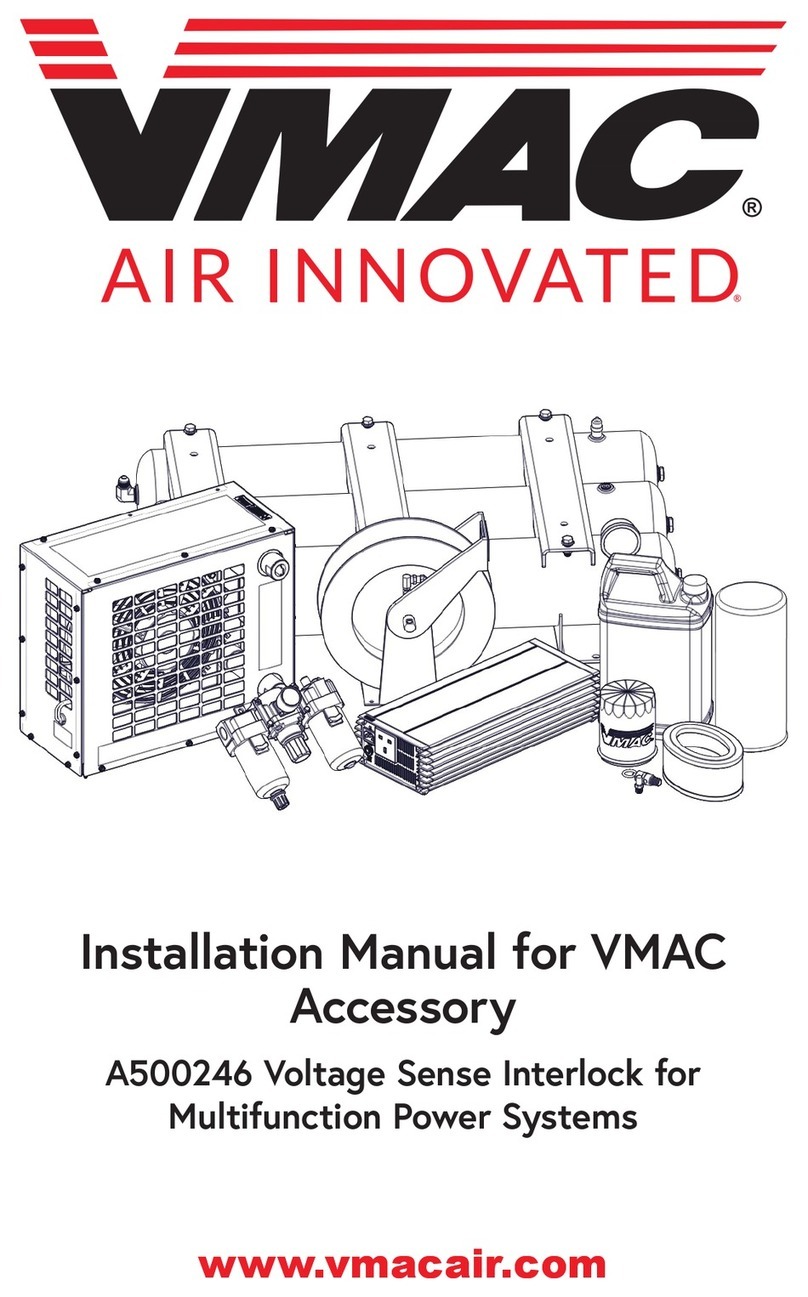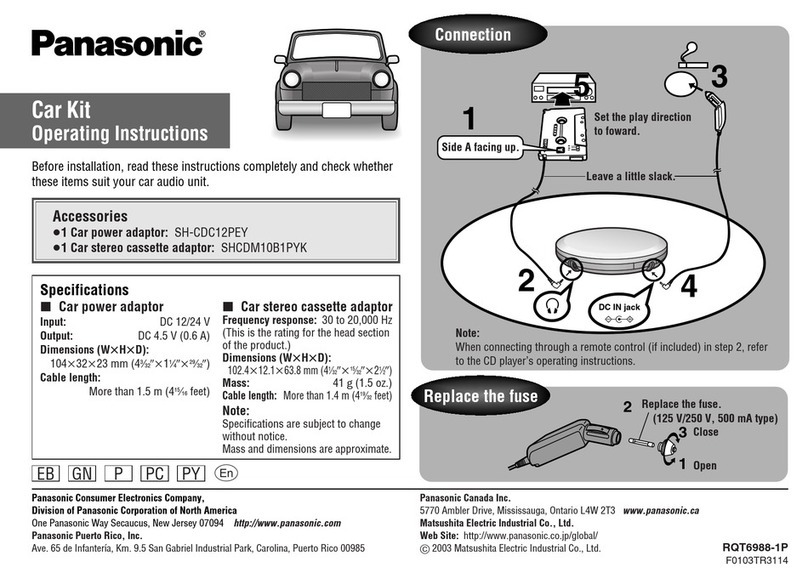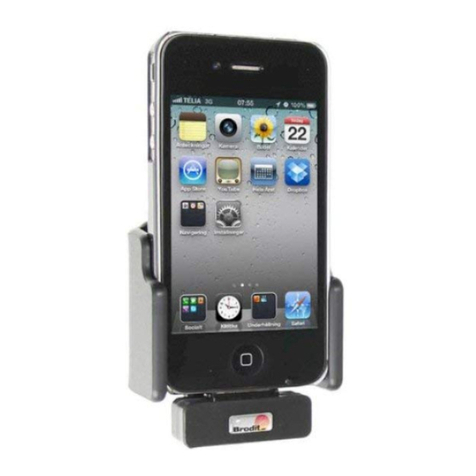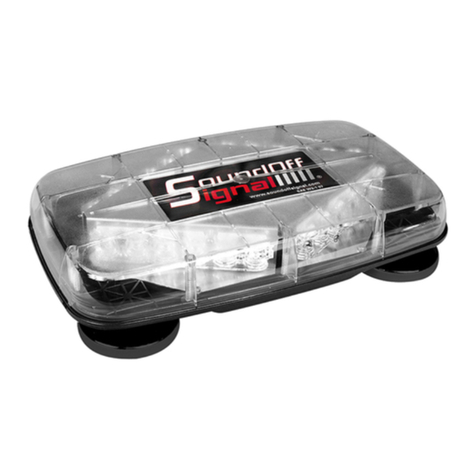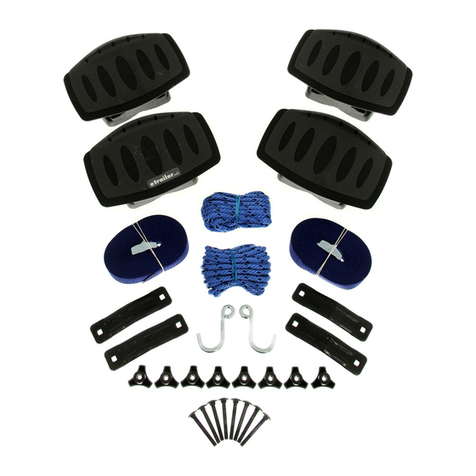Hayes ENERGIZE III User manual

Electronic Brake Controller
Hayes Brake Controller Company
ENERGIZE III P/N# 81741B or ENERGIZE XPC P/N #81745
INSTALLATION MANUAL
ENERGIZE III is for trailers with 2 or 4 electric brakes and vehicles with 12-volt negative ground
systems only.
ENERGIZE XPC is for trailers with 2, 4, or 6 electric brakes and vehicles with 12-volt negative
ground systems only.
READ AND SAVE THESE INSTRUCTIONS
•Before beginning installation, read and become familiar with these instructions.
•Leave in tow vehiclefor future reference.
•Improper installation and operation could cause personal injury and/or equipment and
property damage.
SAFETY INFORMATION
!
!
WARNING: Indicates a potentially hazardous situation that,
if not avoided, could result in death or serious, personal injury.
CAUTION: Indicates a potentially hazardous situation that,
if not avoided, could result in damage to product or property.
TIP: Contains helpful information to facilitate installation.

Installation
Mounting angle and mounting direction
Mounting angles between –35 and + 90 degrees can be accommodated by the controller. THE UNIT
MUST, HOWEVER, BE INSTALLED SO THAT IT IS PARALLEL WITH THE TRAVEL OF THE TOW
VEHICLE AND TRAILER.
CAUTION:
•In the automatic mode, noticeable braking is applied only when
the pendulum sensor detects deceleration.
•With the vehicle at rest and the brake pedal depressed, there
should be only a slight output to the trailer brakes.
!
Anchor Holes Red Indicator Light
Manual Slide
Lever
Gain Wheel
Pendulum
Lever Arm
Fi
g
ure 1 - front view of Ener
g
ize III or Ener
g
ize XPC
Acceptable Mounting Angles
Anchor Holes
(4 ea. side)
Mounting
Bracket
Pendulum Leveling Arm Straight Down
Front of Vehicle
-35° to 90°
Figure 2 - acceptable mounting angles

Controller Mounting and Installation
Controller and Bracket mounting
•The controller must be mounted with the back of the controller toward the front of the vehicle.
•Use the reversible slotted mounting bracket.
•Do not mount the controller upside down or sideways.
WARNING:
•If the controller is mounted incorrectly, the pendulum cannot operate
correctly and may cause loss of braking.
!
Tinnerman Nut
Self
Tapping
Screws
Pan Head
Machine
Screw
Mounting
Bracket
Figure 3 – attachment of mounting bracket

Installation Steps
1. Install the mounting bracket to a solid surface under the tow vehicle dash using the two machine
screws and fasteners provided. Tighten until snug. See Figure 3 – attachment of mounting
bracket.
2. Insert four of the self tapping screws provided through the mounting bracket holes and into the
desired controller anchor holes. Tighten until snug.
3. Mount in a location which allows the driver to easily apply the manual override and to see
the red indicator light.
WARNING:
•All four controller wires must be connected properly for the controller to
operate correctly.
•Failure to properly connect all four wires can cause loss of trailer braking.
•Improper wiring will destroy the controller and void the manufacturer’s
warranty.
WARNING:
•Use of longer screws than those provided can damage the unit and cause
loss of braking.
CAUTION:
•Care must be taken to ensure that the mounting surface is rigid enough to
prevent excessive vibration.
•Excessive vibration may result in poor performance.
!
!
!

Read the wiring instructions completely before you begin
wiring the controller to the tow vehicle.
WARNING:
Follow wiring instructions.
•Improper wiring will destroy the controller and void the manufacturer’s warranty.
!
WARNING:
To reduce the risk of injury or damage to property:
•Always connect the white wire first and the black wire second.
•All four controller wires must be connected properly for the controller to operate
correctly.
•Failure to connect the wires correctly can cause loss of trailer braking.
!
WARNING:
•The white wire must be connected to a known good ground (preferably the negative
battery post).
•Improper or no ground will result in poor controller performance or lack of
performance altogether.
•Improper ground connection can destroy the controller and void the manufacturer’s
warranty.
!
WARNING:
•Improper connections may result in no trailer brakes or destroy the controller and
void the manufacturer’s warranty.
!
CAUTION:
•DO NOT connect the black wire to any vehicle power supply line or fuse panel. This
could cause circuit overload or damage to tow vehicle wiring and vehicle
electronics.
•Route the black wire through a grommet hole in the fire wall to prevent wire
grounding and away from the radio antenna to reduce any possible AM radio
interference.
!

Controller Wiring Instructions
The following chart describes the function of each of the controller’s wires:
IMPORTANT: Make all controller wiring connections to the wiring harness before connecting the
harness to the vehicle.
Order Color Function Wire
Size
(AWG)
Connect To
1st White Ground 16 grounded metal part of the firewall or directly to the
negative (-) terminal of the battery.
2nd Black + connection
to the
vehicle’s
power system
12 positive (+) terminal of the battery. MUST have a
self-resetting Circuit Breaker in-line between the
controller and the battery. See chart for proper size.
Route the black wire through a grommet hole in the
fire wall to prevent wire grounding and away from the
radio antenna to reduce any possible AM radio
interference.
3rd Red Stoplight 14 non-powered stop lamp wire (of the stop lamp switch)
or trailer tow wiring harness. It is recommended that
a 20-amp inline fuse be installed between the
controller’s red wire and the stop lamp switch. The
fuse is required in 1999 & later Fords.
4th Blue Output to
trailer brakes 14 the trailer brake wire or tow vehicle / trailer connector.
SELF-RESETTING CIRCUIT BREAKER
SIZE CHART
Number of Trailer Brakes
Number of Brake
Light Bulbs (tow
vehicle plus trailer) 2 Brakes 4 Brakes 6 Brakes
4 Bulbs (minimum) 20 AMP 30 AMP 30 AMP
5 Bulbs 20 AMP 30 AMP 30 AMP
6 Bulbs 20 AMP 30 AMP 40 AMP
7 Bulbs 30 AMP 30 AMP 40 AMP
8 Bulbs 30 AMP 30 AMP 40 AMP
9 Bulbs 30 AMP 40 AMP 40 AMP
Note: Each trailer brake magnet is assumed to draw 3 amps of
current and each brake lamp bulb is assumed to draw 2 amps.
TIP:
•Special Dual-Mated “Quik ConnectTM” Wiring Harnesses are available for all Hayes
Brake Controllers fitted with a connector on the wire leads, making connection a
snap. Harnesses are available through all dealer resources. Ask specifically for the
Ha
y
es Brake Controller Com
p
an
y
(
HBC
)
brand harnesses to match
y
our controller.

Special Conditions
For tow vehicles equipped with factory trailer towing package:
•Refer to your vehicle’s owner’s manual or other information provided by the manufacturer to determine
the correct connection points for the controller.
•See Appendix section for a partial list of manufacturer wiring harness to controller conversions.
For vehicles withouta trailer-towing package: refer to the wiring diagram in Figure 4.
WARNING:
All 1999 and later Ford vehicles without the trailer wiring package:
•The red controller wire must be connected to the light green wire of the brake
stop lamp through a 20-amp inline fuse.
•Failure to install a 20-amp inline fuse can destroy the controller and void the
manufacturing warranty.
!
WARNING:
1989-1991 Ford Bronco, Econoline, F-Superduty, and F150-350 Series:
•The red stoplight wire MUST splice into the turn signal connector harness and
NOT to the stoplight switch.
•Connecting to the terminal of the stoplight switch will break the switch and result
in no stoplights and no trailer braking.
!
VEHICLE MECHANICAL
STOP LIGHT SWITCH
NON-POWERED STOPLIGHT WIRE
20A
20 AMP INLINE FUSE
CHASSIS/GROUND
RED
BLACK
WHITE
BLUE
USE SELF-RESETING
CIRCUIT BREAKER
SEE CHART
STOP LAMPS
12 VOLT
BATTERY
TOW VEHICLE/TRAILER
ELECTRICAL CONNECTOR
TRAILER BRAKES
TRAILER GROUND
GROUND
(NOT FURNISHED)
(NOT FURNISHED)
SW
POSITIVE
(+)
(-)
NEGATIVE
OR
FOR SIZE
CB
ENERGIZE III
ENERGIZE XPC
Figure 4 - wiring diagram
TIP: ENERGIZE XPC only
•Replace supplied telephone handset cord with a longer cord for trouble shooting.
Connect the remote with longer cord and stand beside trailer wheels. Energize the
remote and verify that the brake magnets hum.
•Verify that the vehicle and trailer stoplights come on when the remote is energized.
•Use supplied handset cord while towing the trailer.

Appendix
OEM TOW VEHICLE WIRING CONVERSION
CHRYSLER (THROUGH 2002) CONTROLLER FUNCTION CHRYSLER (NEW)
RED W/BLACK TRACE BLACK +12 VOLT SUPPLY WHITE WITH RED TRACE
WHITE W/TAN TRACE RED STOPLIGHT BLUE WITH WHITE TRACE
BLUE BLUE TRAILER BRAKES BLUE
BLACK WHITE GROUND GREEN WITH BLACK TRACE
FORD (THROUGH 2002) CONTROLLER FUNCTION FORD (NEW)
RED BLACK +12 VOLT SUPPLY PINK
LIGHT GREEN RED STOPLIGHT RED
BLUE BLUE TRAILER BRAKES BLUE
WHITE WHITE GROUND WHITE
BROWN NOT USED ILLUMINATION BROWN
FORD EXPEDITION CONTROLLER FUNCTION
RED BLACK +12 VOLT SUPPLY
RED/GREEN TRACE RED STOPLIGHT
BLUE BLUE TRAILER BRAKES
BLACK WHITE GROUND
GENERAL MOTORS CONTROLLER FUNCTION
RED BLACK +12 VOLT SUPPLY
LIGHT BLUE RED STOPLIGHT
DARK BLUE BLUE TRAILER BRAKES
BLACK WHITE GROUND
BROWN NOT USED ILLUMINATION
2004 INFINITY CONTROLLER FUNCTION
RED BLACK +12 VOLT SUPPLY
RED/GREEN RED STOPLIGHT
BROWN/WHITE BLUE TRAILER BRAKES
BLACK WHITE GROUND
RED/BLUE NOT USED ILLUMINATION
RANGE ROVER CONTROLLER FUNCTION
REMOVE TAIL LIGHT AND BLACK +12 VOLT SUPPLY
CONNECT RED RED STOPLIGHT
CONTROLLER WIRE TO BLUE TRAILER BRAKES
BLACK/BLUE TRACE, NO WHITE GROUND
LIGHT WITH MANUAL NOT USED ILLUMINATION
2004 TITAN/ARMADA CONTROLLER FUNCTION
RED BLACK +12 VOLT SUPPLY
RED/GREEN RED STOPLIGHT
BROWN/WHITE BLUE TRAILER BRAKES
BLACK WHITE GROUND
RED/BLUE NOT USED ILLUMINATION
2004 TOYOTA TUNDRA CONTROLLER FUNCTON
BLACK-RED BLACK +12 VOLT SUPPLY
GREEN-WHITE RED STOPLIGHT
RED BLUE TRAILER BRAKES
BROWN WHITE GROUND

Electronic Brake Controller
Hayes Brake Controller Company
ENERGIZE III P/N# 81741B or ENERGIZE XPC P/N #81745
OPERATION MANUAL
ENERGIZE III is for trailers with 2 or 4 electric brakes and vehicles with 12-volt negative ground
systems only.
ENERGIZE XPC is for trailers with 2, 4, or 6 electric brakes and vehicles with 12-volt negative
ground systems only.
READ AND SAVE THESE INSTRUCTIONS
•Before beginning operation, read and become familiar with these instructions.
•Leave in tow vehiclefor future reference.
•Improper installation and operation could cause personal injury, and/or equipment and
property damage.
SAFETY INFORMATION
!WARNING: Indicates a potentially hazardous situation that,
if not avoided, could result in death or serious, personal injury.
CAUTION: Indicates a potentially hazardous situation that,
if not avoided, could result in damage to product or property.
TIP: Contains helpful information to facilitate operation.
!

Operation Manual
Automatic Operation
CAUTION:
•In the automatic mode, noticeable braking is applied only when the
pendulum sensor detects deceleration.
•With the vehicle at rest and the brake pedal depressed, there should be
only a slight output to the trailer brakes.
!
1. During braking, the trailer brakes will work in direct proportion to the tow vehicle braking effort.
2. The more deceleration detected by the pendulum sensor, the greater the amount of power delivered
to the trailer brakes.
3. The controller red indicator light (Figure 1) will illuminate from dim to bright during the stop and will
return to dim when deceleration is no longer detected.
4. When the tow vehicle brake pedal is released, the controller and red indicator light will be turned
off.
Anchor Holes Red Indicator Light
Manual Slide
Lever
Gain Wheel
Pendulum
Lever Arm
Figure 1 - front view ENERGIZE III and ENERGIZE XPC

Gain Wheel Adjustment (for Automatic only)
WARNING:
•Improper adjustment of the controller could result in loss of trailer brakes,
aggressive, grabby, pulsating, or delayed trailer brakes.
•Gain wheel adjustments may be required based upon speed, trailer load, and
road conditions.
•Maximum trailer braking occurs just prior to lockup of the trailer wheels.
•Trailer brake lockup could cause loss of control of the trailer and / or the tow
vehicle.
!
•The gain wheel (Figure 1) is located on the front left side of the controller.
•The gain wheel is used to adjust the amount of current to the trailer brakes. It is responsible for
obtaining a smooth, proportional, and optimum tow vehicle and trailer brake response.
•To increase the amount of current required, rotate the gain wheel upward toward the top of the
case.
•To decrease the amount of current required, rotate the gain wheel downward toward the bottom of
the case.
Leveling Arm Pointing Straight Down
Pendulum Leveling Arm Straight Down
Front of Vehicle
Pendulum
Leveling Arm
Figure 2 – initial level setting

Adjusting the Pendulum
!WARNING:
•Improper adjustment of the pendulum may result in poor performance of trailer
brakes.
•Brakes may be unresponsive, grabby, delayed, or pulsating.
A. Connect the trailer to the tow vehicle for this adjustment. If a load leveling hitch system is used, it
should be connected and operational. Locate the tow vehicle and trailer on a flat level surface.
Make sure the tow vehicle stop lamps are operating correctly and disconnect the tow vehicle/trailer
electrical connection.
B. Adjust the gain wheel to its maximum setting.
C. Depress the brake pedal far enough to turn on the vehicle stop-lamps. Hold this position.
D. Pull the pendulum leveling arm (Figure 1) toward the red indicator light. The red indicator light
should illuminate bright red.
E. Push the pendulum-leveling arm away from the indicator light until the light just reaches minimum
brilliance. The leveling arm (Figure 2) should be approximately straight down. Repeat steps D and
E several times to make sure the indicator light has just reached minimum brilliance.
F. Release the brake pedal. The pendulum is now initially adjusted. A readjustment may be
necessary if the loading of either the tow vehicle or trailer causes a considerable change in the tow
vehicle front to rear position. Also a further readjustment may be desired during road test and
performance adjustments.
Manual Operation
WARNING:
Manual operation via the manual slide lever may not disengage the Cruise
Control on some vehicles.
!
•The “Manual Slide Lever” (Figure 1) is located on the front right side of the controller.
•The further the manual slide lever is moved from the right to the left, the greater the amount of
trailer braking power.
•The manual slide lever operation is an independent circuit and overrides the gain wheel
adjustment to allow full braking effort when required.
•The Manual Slide Lever is used to apply the trailer brakes independently of the tow vehicle brakes
or to override the automatic trailer brakes when more braking is required.
•The manual slide lever is used in emergency stop situations when more braking may be required
than is available with the Gain Wheel adjustment or for control of excessive trailer sway.
•The tow vehicle and trailer brake stoplights will be illuminated during the manual lever activation.
TIP:
It is normal to hear the trailer brake magnets “hum” when operating the trailer brakes.

Troubleshooting using the manual slide
To verify the brake controller is properly wired, follow these steps:
A. Disconnect the tow vehicle/trailer electrical connector. Move the manual slide lever (Figure 1) to
the left. The red indicator light must become increasingly brighter and the tow vehicle stop lamps
must illuminate.
B. If the red indicator light does not illuminate or glows dimly, the tow vehicle has a short to ground in
the trailer brake circuit or the white ground wire is not connected to ground. Check and/or repair
wiring and tow vehicle/trailer connector.
C. If the stop lamps do not illuminate, check the red stoplight wire connection of the brake controller
for connections to the non-powered stop lamp wire of the vehicle stop lamp switch.
D. Connect the tow vehicle/trailer electrical connector.
E. Move the manual lever to the left. The red indicator light must illuminate from dim to bright and the
trailer stop lamps must illuminate.
F. If the red indicator light does not illuminate or glows dimly, check the trailer brake magnets and
trailer brake circuit (including the tow vehicle/trailer connector) for a short to ground.
G. If the trailer stop lamps do not illuminate, check and repair trailer wires, bulbs, bulb ground
connections, and the tow vehicle/trailer connector.
H. Also check the red stop light wire connection of the brake controller for connections to the non-
powered stop lamp wire of the vehicle stop lamp switch.
Red Indicator Light representation while brakes are applied manually
1) Dim to bright red illumination:
•Controller operating normally with power to the trailer brakes.
2) Dim to No red illumination:
•Faulty white ground wire connection, or faulty black battery (+) wire connection, or blue wire
is shorted to ground.

Manual Remote Operation (ENERGIZE XPC only)
WARNING:
•Remote unit must be controlled by vehicle operator only.
•Manual operation via the manual remote may not disengage the
Cruise Control on some vehicles.
WARNING:
•Always keep remote unit clear and away from obstructions to reduce the
possibility of undesired trailer brake activation.
•If not using the remote, disconnect the remote from the controller.
!
!
•The “manual remote” (optional for the ENERGIZE XPC; see Figure 3) can be connected to the
jack, shown in (Figure 4), located on the side of the controller.
•The further the red manual energize button is depressed, the greater the amount of trailer braking
power.
•The manual remote operation is an independent circuit and overrides the gain wheel adjustment to
allow full braking effort when required.
•The manual remote is used to apply the trailer brakes independently of the tow vehicle brakes or to
override the automatic trailer brakes when more braking is required.
•The manual remote is used in emergency stop situations when more braking may be required than
is available with the gain wheel adjustment or for control of excessive trailer sway.
•The tow vehicle and trailer brake stoplights will be illuminated during the manual remote activation.
Remote
Plug
Manual
ENERGIZE
Button
OPTIONAL
Manual Remote
Figure 3 – optional remote
(ENERGIZE XPC ONLY)
Manual Remote Jack
Figure 4 – remote jack
(ENERGIZE XPC ONLY)
TIP: ENERGIZE XPC only
•Replace supplied telephone handset cord with a longer cord for trouble shooting.
Connect the remote with longer cord and stand beside trailer wheels. Energize the
remote and verify that the brake magnets hum.
•Verify that the vehicle and trailer stoplights come on when the remote is energized.
•Use supplied handset cord while towing the trailer.

Road Test and Performance Adjustments
To adjust the gain wheel (Figure 1) with the trailer connected.
A. Locate the tow vehicle and trailer on a flat, hard, dry surface.
B. Adjust the gain wheel to the midrange setting.
C. At a moderate speed (25 mph or less) push on the tow vehicle brake pedal in a normal manner. A
firm braking action should occur.
D. The red indicator light should illuminate from dim to bright during the stop and back to dim after the
stop is completed.
E. If more trailer braking is required, increase the gain wheel. If less trailer braking is required,
decrease the gain wheel.
F. At a moderate speed (25 mph or less) move the manual lever slowly to the left. A much harder
stop can always be obtained, as the gain wheel setting does not affect the manual lever. The red
indicator light should illuminate from dim to bright during the stop.
G. At a moderate speed (25 mph or less) press the manual remote button slowly (only for ENERGIZE
XPC with remote option). A much harder stop can always be obtained, as the gain wheel setting
does not affect the manual remote. The red indicator light should illuminate from dim to bright
during the stop.
H. Readjustment of the pendulum-leveling arm: If the conditions described in items 1 and 2 below
occur, refer to Figures 2, 5, and 6 for the affects of pendulum leveling arm adjustment
1. Pendulum leveling arm adjusted too far to the rear of the controller (Figure 5):
•No indicator light
•Delayed braking
•No braking
2. Pendulum leveling arm adjusted too far toward the front of the controller (Figure 6):
•Steady illuminated indicator light
•Grabbing trailer brakes
•Trailer brakes will pulse with 4-way flasher light
3. Pendulum leveling arm adjusted correctly (Figure 2):
•Dim indicator light when vehicle is stopped on level surface
•Increasing indicator light as pedal effort is increased while stopping
•Smooth braking
OFF LEVEL
Delayed or No
Trailer Brakes
OFF LEVEL
Aggressive or Grabby
Trailer Brakes
Figure 5 – delayed or no trailer brakes Figure 6 – aggressive or grabby brakes

TIP:
•Warm trailer brakes tend to be more responsive than cold brakes.
Braking on Hills
When properly adjusted, the controller will allow a slightly greater amount of trailer braking going downhill
and slightly less trailer braking going uphill. Normally, no controller readjusting is needed for towing in the
hills.
Trailer Braking with 4-way Flashers Operating
A. With the controller properly adjusted, the red indicator light may flash with the 4-way flasher lights,
but will not operate the trailer brakes. (Figure 5)
B. If the controller is not adjusted correctly; the trailer brakes can possibly pulse with 4-way flasher
lights. (Figure 6)

Troubleshooting
Symptom Possible Cause Remedy
Gain set too high Reduce gain settingTrailer Brakes “Lock
Up” Pendulum leveling arm set too
aggressive Move pendulum arm to a less aggressive position.
See adjusting pendulum section.
Gain set too low Increase gain settingLow output to trailer
brakes Pendulum leveling arm set too
delayed Move pendulum arm to a more aggressive position.
See adjusting pendulum section.
Overloaded trailer Check weight rating
Loose or poor quality connections Inspect connections / check with meter
Insufficient wire gauge Inspect / replace
Weak / Ineffective
Brakes
Trailer brakes out of adjustment Inspect and adjust as needed
Improper Wiring Check color codes of all wires.
Improperly grounded Ensure that the following are grounded:
•
•
•
•
Controller (white wire)
Tow vehicle connector
Trailer umbilical cord
Each brake magnet
No output to trailer
brakes (manual or
automatic)
Trailer brakes out of adjustment Inspect and adjust as needed
No output to trailer
brakes (automatic only) Faulty Brake Light Circuit on tow
vehicle Troubleshoot / repair brake light circuit
Improperly grounded Check and repair all ground connections
Out of Round brake drums Repair / replace
Intermittent or surging
brakes Worn wheel bearings Repair / replace
Direct short to ground either in tow
vehicle wiring or in trailer wiring. Inspect and repair wiringNo output to trailer
brakes, red indicator
light dim or off when
brakes are applied. Faulty brake magnets Test / replace brake magnets
Too many brake magnets are
attached to controller Energize III only handles 1-2 axles with brakes.
Energizer XPC only handles 1-3 axles with brakes.
Intermittent short to ground in tow
vehicle or trailer wiring Inspect and repair wiring
Reduced output to
trailer brakes, red
indicator light stops
increasing in
brightness with
increased braking
requirements.
Defective brake magnets Test / replace brake magnets
Trailer brakes lock up
when trailer connector
cable is attached.
Faulty breakaway switch Test / replace switch
Indicates presence of an unexpected
12 Volts on the blue (output) wire
due to one of the following:
•
•Faulty wiring
Malfunctioning break-away
switch
Inspect wiring and breakaway switch. Ensure that
there is no voltage on the blue wire when the brake
pedal is not depressed.
Controller red indicator
on all the time.
Indicates presence of an unexpected
12 Volts on the red. Inspect wiring. Ensure that there is no voltage on
the red wire when the brake pedal is not depressed.
Feel the difference with Hayes. Learn more about trailer hitches and towing we have.
This manual suits for next models
1
Table of contents
Other Hayes Automobile Accessories manuals

